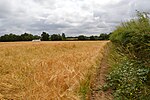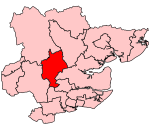Writtle University College
1893 establishments in EnglandAgricultural universities and colleges in the United KingdomEducational institutions established in 1893University of EssexUse British English from August 2015
Writtle University College is a university college located in Writtle near Chelmsford, Essex. It was founded in 1893. Writtle obtained University College status in May 2016.Its countryside estate features a wide range of facilities, including a working farm, an equine centre, science laboratories, design studios, a canine therapy clinic, a specialist animal unit and sports provision including the UK's first permanent 3x3 basketball courts.
Excerpt from the Wikipedia article Writtle University College (License: CC BY-SA 3.0, Authors).Writtle University College
Cow Watering Lane, Chelmsford Writtle
Geographical coordinates (GPS) Address Nearby Places Show on map
Geographical coordinates (GPS)
| Latitude | Longitude |
|---|---|
| N 51.7399 ° | E 0.4146 ° |
Address
Cow Watering Lane
Cow Watering Lane
CM1 3SB Chelmsford, Writtle
England, United Kingdom
Open on Google Maps






